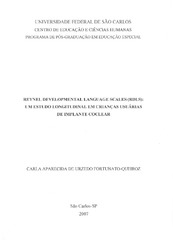| dc.contributor.author | Fortunato-Queiroz, Carla Aparecida de Urzedo | |
| dc.date.accessioned | 2016-06-02T19:44:01Z | |
| dc.date.available | 2007-11-22 | |
| dc.date.available | 2016-06-02T19:44:01Z | |
| dc.date.issued | 2007-02-28 | |
| dc.identifier.citation | FORTUNATO-QUEIROZ, Carla Aparecida de Urzedo. Reynel developmental language scales (RDLS) : um
estudo longitudinal em crianças usuárias de implante
coclear.. 2007. 164 f. Tese (Doutorado em Ciências Humanas) - Universidade Federal de São Carlos, São Carlos, 2007. | por |
| dc.identifier.uri | https://repositorio.ufscar.br/handle/ufscar/2832 | |
| dc.description.abstract | The objectives of this work were to analyze the language development of deaf children
using a cochlear implant (CI) through a longitudinal study using the Reynell Developmental
Language Scales (RDLS), to compare the performance of the deaf children to the
performance of children with normal hearing, and to correlate it with the time of use of the
CI. The participants were 17 6-year-old children with normal hearing and 9 deaf children
using CI. The chronological age of the deaf children ranged from 4 to 8 years-old. The
time of use of CI was, on average, 1 year 6 months at the 1st evaluation, 3 years 7 months at
the 2nd evaluation, and 4 years 9 months at the 3rd evaluation. The deaf children were
evaluated longitudinally through the RDLS, which is composed of the Verbal
Comprehension Scale and Expressive Language Scale. The data were analyzed qualitatively
and quantitatively. The implanted children showed progress of both their receptive and
expressive abilities that were statistically significant but inferior to the children with normal
hearing. In the verbal comprehension the differences between means and medians of scores
of the deaf children and of the normal children were statistically significant. In the
expressive language there was not a statistically significant difference. There was no
correlation between the answers in both scales and the time of use of the CI for this group
of deaf children, probably had to the reduced number of children of this group. The study
proves the efficacy of the CI to the development of receptive and expressive language
abilities and shows that the RDLS is effective in the longitudinal evaluation of deaf children
using CI. Fortunato-Queiroz, C.A.U (2005) Reynell Developmental Language Scales (RDLS): Une
étude longitudinale d´ enfants porteur de l´implant coclear. Thèse de Doctorat. Programme
de Pós-Graduação dans Éducation Spéciale. Universidade Federal de São Carlos. São
Carlos, SP | eng |
| dc.format | application/pdf | por |
| dc.language | por | por |
| dc.publisher | Universidade Federal de São Carlos | por |
| dc.rights | Acesso Aberto | por |
| dc.subject | Educação especial | por |
| dc.subject | Deficientes auditivos | por |
| dc.subject | Implante coclear | por |
| dc.subject | Linguagem expressiva | por |
| dc.subject | Linguagem receptiva | por |
| dc.title | Reynel developmental language scales (RDLS) : um
estudo longitudinal em crianças usuárias de implante
coclear. | por |
| dc.type | Tese | por |
| dc.contributor.advisor1 | Costa, Maria da Piedade Resende da | |
| dc.contributor.advisor1Lattes | http://genos.cnpq.br:12010/dwlattes/owa/prc_imp_cv_int?f_cod=K4787585J1 | por |
| dc.description.resumo | Os objetivos deste estudo foram analisar o desempenho da linguagem de crianças surdas
usuárias de implante coclear (IC) por meio de um estudo longitudinal, utilizando-se a
Reynell Developmental Language Scales (RDLS), comparar o desempenho das crianças
surdas com o desempenho de crianças ouvintes e correlacioná-lo com o tempo de uso do IC.
Os participantes foram 17 crianças ouvintes de 6 anos de idade e 9 crianças surdas usuárias
de IC. A idade cronológica das crianças surdas variou entre 4 e 8 anos e o tempo de uso do
IC foi, em média, 1 ano e 6 meses na 1ª avaliação, 3 anos e 7 meses na 2ª avaliação e 4 anos
e 9 meses na 3ª avaliação. As crianças surdas foram avaliadas longitudinalmente por meio
da RDLS, que é composta pelas Escalas de Compreensão e Expressão Verbal. Os dados
foram analisados qualitativa e quantitativamente. Os resultados mostraram que as crianças
implantadas obtiveram uma evolução significativa estatisticamente em relação às
habilidades de linguagem receptiva e expressiva, todavia os resultados foram inferiores aos
apresentados pelas crianças ouvintes. Para a compreensão verbal, a diferença entre as
médias e medianas das crianças surdas e das crianças ouvintes foi significativa
estatisticamente. Para a expressão verbal, porém, essa diferença não foi significativa. Não
foi encontrada correlação entre as respostas de compreensão e expressão verbal e o tempo
de uso do IC para este grupo de crianças surdas, devido provavelmente ao número reduzido
de crianças deste grupo. O estudo comprova a efetividade do IC para o desenvolvimento das
habilidades de linguagem receptiva e expressiva e demonstra que a RDLS é eficaz na
avaliação longitudinal de crianças surdas usuárias de IC. | por |
| dc.publisher.country | BR | por |
| dc.publisher.initials | UFSCar | por |
| dc.publisher.program | Programa de Pós-Graduação em Educação Especial - PPGEEs | por |
| dc.subject.cnpq | CIENCIAS HUMANAS::EDUCACAO::TOPICOS ESPECIFICOS DE EDUCACAO::EDUCACAO ESPECIAL | por |
| dc.contributor.authorlattes | http://lattes.cnpq.br/3790610494469855 | por |
